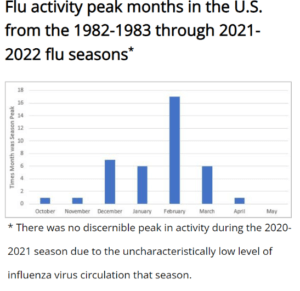According to reports from medical centers around the country, there are already many cases of influenza popping up all over, and even some people having to be hospitalized. This is not the normal pattern, because in the past, the earliest signs of the annual flood usually only showed up in November. Now, cases have been reported throughout the second half of October.
The Center for Disease Control and Prevention (CDC) says that “flu viruses typically circulate during the fall and winter during what’s known as the flu season. The exact timing and duration of flu seasons varies, but … most of the time flu activity peaks between December and February.” They go on to confirm what we reported a few months ago, when we wrote that the timing and duration of flu activity has been less predictable since the onset of the COVID-19 pandemic.
As we wrote, based on the experience of Southern Hemisphere countries like Australia and New Zealand, the arrival of COVID-19 at the start of 2020 broke an established pattern of how the influenza virus swept through countries with the onset of winter. In 2020 and 2021, the battle against the coronavirus took precedence. Self-isolation, mask-wearing and work-from-home programs removed a large proportion of the population from mixing physically, so influenza rates dropped dramatically.
The numbers of flu cases were so low compared to prior years that they didn’t even show up on a chart compared to the millions in prior years. Only in 21/22, once the COVID-19 pandemic had come to be at least manageable, if not defeated, did flu numbers start to climb to anything near the levels of previous years.
Learning from the experience of Australia
In the winter season of 2022 in Australia (May – July) there was a wave of flu cases, with rates that have eclipsed those in the pre-pandemic years. Since the start of May, the weekly number of confirmed cases has exceeded the five-year average.
Some features of the spread of influenza in Australia this year should be adding to the concerns of Northern Hemisphere countries. This year, cases started to spike as early as April, and the massive numbers seen in July, only halfway through winter, suggested that new flu strains were circulating in the Southern Hemisphere. Australia has also seen more than 47,000 new coronavirus cases daily since February, mainly due to Omicron variants.
What does this mean for the US?
Signs are already showing up that influenza is peaking earlier than normal, and that the variety of the virus is unexpected. Reports on the web news channel CNNHealth com gather numerous incidence across California in schools and colleges where hundreds of students are missing class because they are laid low with the flu. San Diego Unified School District said that there were about 1,000 absences on one day, out of 2,600 students.
The CDC weekly report for the week ending 21st October (Week 41) says that “Early increases in seasonal influenza activity have been reported in most of the United States, with the southeast and south-central areas of the country reporting the highest levels of activity.”
Nationwide during week 41, three percent of all patient visits reported were for respiratory illness that included fever plus a cough or sore throat. This represents a 225% increase above the figure recorded for 2019 – the last year before the pandemic.
What are the possible remedial steps?
Americans have developed “vaccine fatigue” over the past year. As a result, they may decide to skip both the standard influenza vaccine and any of the new COVID-19 mRNA vaccine boosters targeting the BA.5 and Omicron variants. This will put them at serious risk of contracting both flu and covid and of infecting people around them.
The CDC emphases that getting back on track with vaccines is the essential step that all federal and state health authorities should be taking. The simple answer is:
- An annual flu vaccine is the best way to protect against flu. Vaccination helps prevent infection and can also prevent serious outcomes in people who get vaccinated but still get sick with flu.
- CDC recommends that everyone aged 6 months and older get a flu vaccine, ideally by the end of October.
- There are also prescription flu antiviral drugs that can be used to treat flu illness; those need to be started as early as possible.
Roll up your sleeves and get the jabs!
















